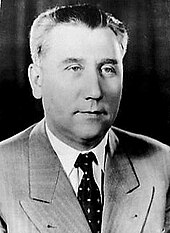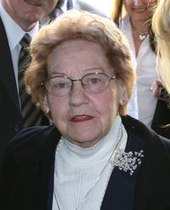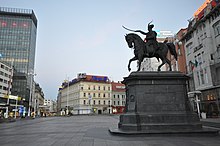Croatian Spring
In the late 1960s, a variety of grievances were aired through Matica hrvatska, which were adopted in the early 1970s by a reformist faction of the SKH led by Savka Dabčević-Kučar and Miko Tripalo.
Bakarić persuaded Krste Crvenkovski, the head of the League of Communists of Macedonia (SKM), to support the Slovene–Croatian reformist bloc, which managed to enact substantial legislation curbing federal powers in favour of the republics.
[6] By the mid-1960s, the United States consul in Zagreb, Helene Batjer, estimated that about half of SKH members and 80 percent of the population of Croatia held nationalist views.
Croatian media reported that favourable purchase agreements for Serbian companies were the result of political pressure and bribery, and the situation was framed as an ethnic rather than economic conflict.
[23] Many people in Croatia believed these to be substantive threats intended to weaken the republic, and rejected alternate explanations of them attributing the changes to economic phenomena or results of modernisation.
[22] Early in 1969, a number of grievances were listed in an article by the Croatian Writers' Association president, Petar Šegedin, in Kolo, a magazine published by Matica hrvatska.
[31] The party was led by a reformist faction consisting of SKH Secretary of the Central Committee Savka Dabčević-Kučar and Miko Tripalo, supported by Pero Pirker, Dragutin Haramija, Ivan Šibl, and others.
[32] The reformists were opposed by a conservative or anti-reformist faction including Žanko and Stipe Šuvar, Dušan Dragosavac, Jure Bilić, and Milutin Baltić [hr].
Others accused by Žanko of stirring up nationalist views were writers Šegedin, Gotovac, and Tomislav Ladan; literary critics Vlatko Pavletić, Igor Mandić and Branimir Donat [hr]; Vjesnik u srijedu weekly editor Krešimir Džeba and Vjesnik political columnist Neda Krmpotić; editor of Roman Catholic Archdiocese of Zagreb-published weekly Glas Koncila Živko Kustić, historian Trpimir Macan, art historian Grgo Gamulin, as well as economists Đodan, Hrvoje Šošić [hr], Marko and Vladimir Veselica.
[42] Within days of the student-body elections, Tito requested that Dabčević-Kučar order the arrests of Šegedin, Marko Veselica, Budiša, Čičak and Đodan, but she declined.
At a rally of 200,000 people to mark the 26th anniversary of the 1945 liberation of Zagreb on 7 May, observers from the United States reported that her speech was interrupted about 40 times by cheering and applause directed at her rather than the SKH.
[44] According to the British ambassador to Yugoslavia Dugald Stewart, Dabčević-Kučar and Tripalo were very skilled at use of public political rallies and their speeches drew crowds typically expected only at football matches.
[48] Serbian and Croatian newspapers traded accusations of mutual hostility, nationalism, and unitarism, leading Tito to admit that the SKJ had lost control of the media.
[53] Lijepa naša domovino returned to formal use as a patriotic song when a plaque was placed in the Zagreb Cathedral commemorating the noblemen involved in the 17th-century Magnate conspiracy.
[55][56] Croatia's historical chequy coat of arms became a famous symbol sewn by youths on jackets and berets or applied on stickers to car windshields.
Its cover page carried a photo of the wartime secretary of the Communist Party of Croatia, Andrija Hebrang,[60] whom the SKJ had considered a Soviet spy and a traitor since the 1948 Tito–Stalin split.
While Croats focused on the role of the Royal Serbian Army in the creation of the Serb-dominated Kingdom of Yugoslavia, and killings of collaborationist Ustaše troops and their sympathisers in the 1945 Yugoslav pursuit of Nazi collaborators, Serbs negatively evaluated the Croatian participation in Austria-Hungary's Serbian campaign during World War I, and especially the genocide of Serbs committed by the Ustaše in the Axis puppet state known as the Independent State of Croatia (NDH).
[62] In a series of articles in Hrvatski tjednik, Tuđman expressed the view of the majority of the SKH as well as Matica hrvatska: that Croats had made a significant contribution to the Partisan struggle and were not collectively to blame for Ustaše atrocities.
Furthermore, Prosvjeta denounced the work of Matica hrvatska and asserted that the Serbs of Croatia would preserve their national identity by relying on Serbia's help regardless of the borders of the republics.
[51] In February 1971, the Croatian nationalist émigré magazine Hrvatska država, printed by Branimir Jelić in West Berlin, published a story attributed to its Moscow correspondent claiming that the Warsaw Pact would help Croatia achieve its independence, granting it a status comparable to that enjoyed by Finland at the time.
[74] In September, Matica hrvatska expanded its work to Bosnia and Herzegovina and the Serbian autonomous province of Vojvodina, claiming Croats were underrepresented in government institutions there due to policies implemented during Ranković's tenure.
Some members of the SKH Central Committee suggested that Tito invented it to strengthen his position, but the First Deputy Premier of the Soviet Union Dmitry Polyansky confirmed the conversation took place.
[82] On 12–15 November, Tito visited Bugojno in Bosnia and Herzegovina, where he was hosted by the republic's leadership (Branko Mikulić, Hamdija Pozderac, and Dragutin Kosovac).
On 13 November, they were joined by the Yugoslav prime minister, Džemal Bijedić, who criticised the SKH's demands for changing the distribution of foreign currency earnings.
[83] On 15 November, Tito was joined by the heads of the JNA to view recordings of political rallies in Croatia where nationalists and SKH members spoke and where anti-Tito shouts could be heard.
SKJ presidium members from other republics and provinces then gave speeches supporting the conservative stance, and the SKH leadership was told to control the situation in Croatia.
[98] After the downfall of the reformist SKH leadership, anti-communist émigrés wrote about the Croatian Spring as a movement presaging democratisation and praised Dabčević-Kučar and Tripalo as people of "unusual political virtues".
Consequently, nineteen members of the Croatian Revolutionary Brotherhood terrorist organisation launched an armed incursion into Yugoslavia in mid-1972, hoping to incite a rebellion that would lead to the re-establishment of the NDH.
[102] The 1974 Yugoslav Constitution preserved the 1971 reforms almost entirely, expanded the economic powers of the constituent republics, and granted reformist demands related to banking, commerce, and foreign currency.
During this period, pressure for the complete breakup of Yugoslavia intensified, religious leaders gained influence, and the Partisan legacy that legitimised the state was weakened.










